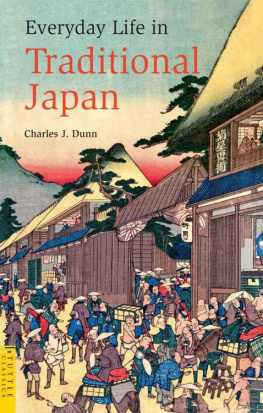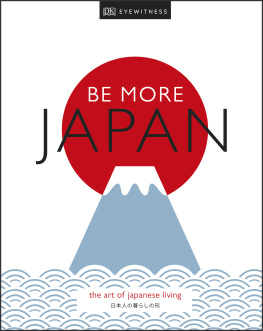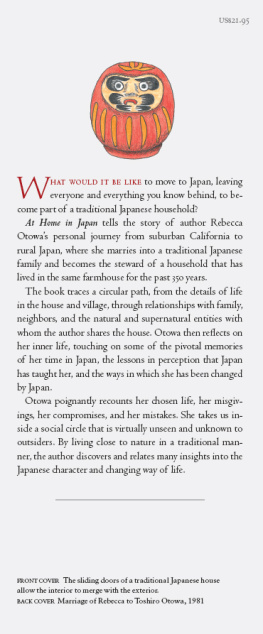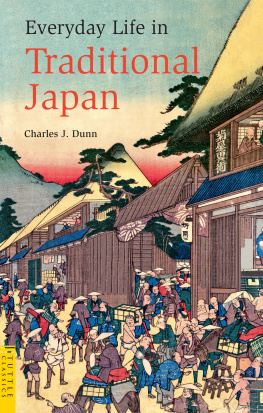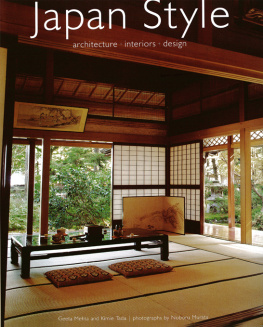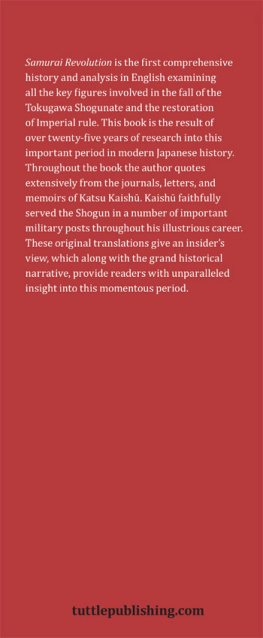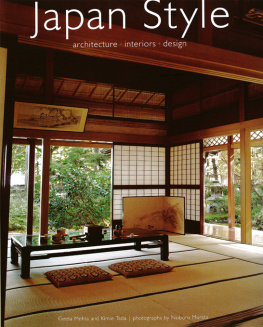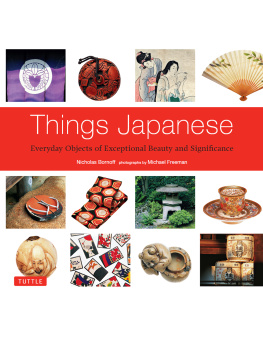Everyday Life in
Traditional
Japan

The black castle of Matsumoto.

Published by Tuttle Publishing, an imprint of Periplus Editions (HK) Ltd., with editorial offices at 364 Innovation Drive, North Clarendon, Vermont 05759-9436 U.S.A. and 61 Tai Seng Avenue, #02-12, Singapore 534167
Copyright 1969 C. J. Dunn
Illustrations 1969 B. T. Batsford
All rights reserved. No part of this publication may be reproduced or utilized in any form or by any means, electronic or mechanical, including photocopying, recording, or by any information storage and retrieval system, without prior written permission from the publisher.
LCC Card No. 72186748
ISBN 978-4-8053-1005-2
ISBN 978-1-4629-1651-1 (ebook)
Distributed by:
North America, Latin America & Europe
Tuttle Publishing
364 Innovation Drive
North Clarendon, VT 05759-9436 U.S.A.
Tel: 1 (802) 773-8930; Fax: 1 (802) 773-6993
www.tuttlepublishing.com
Japan
Tuttle Publishing
Yaekari Building, 3rd Floor
5-4-12 Osaki, Shinagawa-ku, Tokyo 141 0032
Tel: (81) 03 5437-0171; Fax: (81) 03 5437-0755
Asia Pacific
Berkeley Books Pte. Ltd.
61 Tai Seng Avenue, #02-12, Singapore 534167
Tel: (65) 6280-1330; Fax: (65) 6280-6290
www.periplus.com
First edition 1972
12 11 10 09 10 9 8 7 6 5 4 3
Printed in Singapore
TUTTLE PUBLISHING is a registered trademark of Tuttle Publishing, a division of Periplus Editions (HK) Ltd.
CONTENTS
PREFACE
Life in Japan has always had a highly individual flavor. This has not meant that the Japanese have been averse to accepting influences from abroad, and indeed, for most of her history Japan has received many foreign importationswhich she has invariably modified to suit her own needsfirst mainly from China, and during the last hundred years from the West, more recently especially from America. However, there was one long and important period during which the opposite was true, that of the rule of the Tokugawa Shoguns, and that is the period that is the subject of this book.
A visitor from the West is constantly made aware of what seems to him a duality in Japanese life, a mixture of Western and traditional ingredients. Japan, for all the modernity of its economy and for all the impatience that many young Japanese show towards their countrys past, has nevertheless retained very much that is characteristically Japanese. Much of itand this is true of any country that has a historycomes from the past. The political structure of this past is that which came to end in the middle of the nineteenth century, in dramatic manner, with the Meiji Restoration of 1868. It had been inaugurated in 1603, when Tokugawa Ieyasu took over the supreme power as military dictator; after a settling-down period, civil strife came to an end, and there followed more than two centuries of freedom from large- scale conflicts, and also of almost complete isolation from the outside world. This was a time of great stability, in which what was to be the tradition behind present-day Japan thickened and gelled, so that, although there was in fact a certain amount of development within these centuries, they present a largely consistent appearance.
We can, therefore, consider the period from about 1600 to 1850, the years of undisputed Tokugawa rule, as those of Traditional Japan, and the aim of this book is to give the general reader a picture of the background to living in Japan in Tokugawa times.
I wish to express my thanks to my wife, who read and typed the manuscript, and to Mr. Peter Kemmis Betty, of Batsfords, for much help during the preparation of this book, and especially for his care in the final selection of the pictorial material. I should also like to thank Mr. L. Broderick for his splendid drawings, which have provided many illustrations that could not otherwise have been included. The reader will find other vivid pictures of life in pre-Meiji Japan in the color prints of contemporary artists such as Hiroshige and Hokusai.
C.J. DUNN
ACKNOWLEDGMENTS
The author and publishers would like to thank the following for the illustrations appearing in this book: Hyogensha Co. Ltd, Kyoto for fig..
List of Illustrations
. The black castle of Matsu-moto, frontispiece
. Map of Japan, x
. Snow scene, 2
. The crater of Mt Aso, 3
. Flooded rice-fields, 3
. A forest of sugi , 4
. Miyajima, 4
. Stone Buddha of Usuki, 5
. Gion Festival, 6
Samurai in the street, 13
Samurai at the poulterers, 14
. Moat of Osaka Castle, 16
. Himeji Castle, 17
. Audience chamber in Nij Castle, 18
. Samurai in naga-bakama , 19
Samurai in kami-shimo , 19
. Samurai on journey, 21
. Ferry-boat on the Tkaid, 23
. Post-station, 25
. Yoriki and dshin,
. Jitte,
. Shirasu,
. Samurai view flower-arrangement, 32
. Puppet-show in daimy s residence, 35
. Kaempfer at the Shoguns court, 36
. The Shogun attended by ladies-in-waiting, 37
. The Shoguns ladies exercising with the halberd, 38
. The Shoguns ladies at their toilet, 39
. Japanese and Chinese styles of writing, 42
. The Shogun Yoshimune, 43
. Ploughing, 45
. Sprouting rice, 46
. Sowing rice, 47
. Rice-planting, 48
. Three methods of raising water, 49
. A procession of villagers, 51
. Threshing, 52
. Heckling rice, 53
. Growing cotton, 54
. Farm implements, 56
. Womans undergarment, 59
. Farmhouses with characteristic roof-shapes, 60
. Typical hearth, 62
. Famine, 67
. Peasant riot, 69
. Heads of puppets, 72
. Y amabushi,
. A plasterer and his mate, 76
. Two mat-makers, 77
. Two sword-smiths, 78
. Lac-tappers at work, 79
. Sake -brewing, 80
. Stone-masons, 80
. Lacquer chest, 83
. Carpenters and their tools, 84
. Wayside teashop, 88
. Coins, 89
. Money-changers, 91
. Pawnbrokers, 92
. Interior of house at Taka-yama, 93
. Rice-merchants, 97
. Higaki ship, 100
. Chair-men, 102
. The Mitsui house-sign, 103
. Mitsui drapery shop in Edo, 104
. Nikk, 110
. Joss-stick maker, 113
. Two shops for Buddhist supplies, 114
. Manpukuji, 115
. Blind masseur, 120
. Bash, 121
. Actors face, 126
. Girls of Yoshiwara, 127
. One-man theatre, 128
. Sword-swallower, 129
. Room interior, 133
. Various brooms, 134
. China shop, 137
. Stove-maker, 139
. Porcelain sake- jar ,
. Lacquer sake -jar,
. Sake-cups,
. Itinerant oil-seller, 142
. Candle-making, 142
. Man with kotatsu frame, 143
. Seller of round fans, 144
. Mens bath, 145
. Go board, 149
. Battledores for the New Year Festival, 150
. Kite-seller, 152 89. Hanging out washing, 153
. Writing class, 154
. Illustrated bookshop, 155
. Illustration from puppet play-book, 156
. Sake- shop ,
. Story-teller, 159
. Town riot in 1866, 160
. Nightwatchman, 161
. Theatre in 1804, 162
. Fire-fighting tools and watch-tower, 163
. Party in Yoshiwara, 1645
. Pilgrimage to Ise, 167
. Theatre street, 168
. Actor print, 169
. Sum wrestlers, 170

Next page
